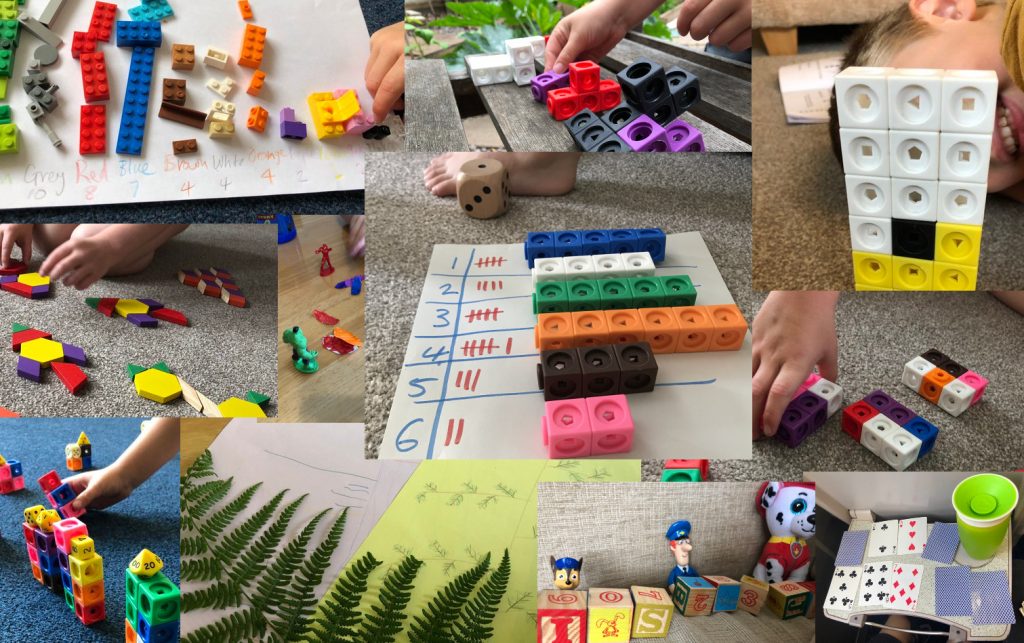#tmwyk: mathematical play and conversations with my kid
The Aperiodical 2019-11-30

#tmwyk is a Twitter hashtag which stands for some approximation of “Talking math(s) with your/young kids”. It is used to share mathematical interactions with children. It is also the subject of my MathsJam talk this weekend.
For me, I tend to use #tmwyk to share playful interactions with my son, following his interests and the mathematics that we find in the world around him. I’m not trying to teach anything in particular, nor am I trying to limit his interests to what might come up at school.
“Algebra?” said Madam Frout … “But that’s far too difficult for seven-year-olds.” “Yes but I didn’t tell them that, and so far they haven’t found out,” said Susan.
Thief of Time, Terry Pratchett.
So it covers some formal things like place-value, should this take his interest.
My 4yo & I are playing with tens and units. pic.twitter.com/rQgHXa7HQg
— Peter Rowlett (@peterrowlett) June 9, 2019
It also includes some recreational maths classics.
A giraffe, a flower/lion’s head, two rockets, some cargo and just constructing a funny sort of bone. So described by my 4yo. #tmwyk pic.twitter.com/X859i9LOFc
— Peter Rowlett (@peterrowlett) July 7, 2019
Further adventures in puzzling with my 3yo. We have a fox, a goose, a bag of beans and a boat. Let’s see if we can get them across this river! pic.twitter.com/SnOGDgfd9C
— Peter Rowlett (@peterrowlett) April 7, 2019
Also some items that might be less curriculum-relevant. His Six and Eight Bridges of Königsberg solutions were superb, as was his Two Utilities Problem.
My 4yo has enjoyed solving the Six and Eight Bridges of Königsberg, and the Two Utilities Puzzle. What other fun, achievable puzzles would you recommend we play with? (I haven’t told him he’s too young for graph theory.) #tmwyk pic.twitter.com/0n6sdJNwK9
— Peter Rowlett (@peterrowlett) October 13, 2019
But it also is just sometimes whatever mundane object has taken his interest.
“Wide, thin, wide, thin, …” he mutters to himself. “What’s that you’re saying?” I ask. “I’m just reading out the mat. There are 8 wide and 7 thin, so wides win!”#tmwyk pic.twitter.com/c6Sm8uWKUQ
— Peter Rowlett (@peterrowlett) October 6, 2019
We’re exploring self-similarity. #fractals #tmwyk pic.twitter.com/9TVsMNbtVu
— Peter Rowlett (@peterrowlett) September 7, 2019
“Do I have more than one thousand pieces of Lego?” (We did some counting.) “Yes!” As a bonus, we noticed 1000 is a square number.#tmwyk pic.twitter.com/QSO1t61YEd
— Peter Rowlett (@peterrowlett) October 27, 2019
Object graphs are good fun.
Object graphs with my 4yo #tmwyk (HT @honeypisquared.) pic.twitter.com/zCaZNmJmTc
— Peter Rowlett (@peterrowlett) July 13, 2019
Object graphs, a game my son calls “sorting things”. Same objects, different classification for cars and dinosaurs. #tmwyk pic.twitter.com/rxyUZJeVNW
— Peter Rowlett (@peterrowlett) November 3, 2019
Number blocks are amazing, and lead to all sorts of mathematical play and interesting insight.
Inspired by @kyledevans’ book, a kind gift by @stecks, we’re trying to arrange blocks into squares, rectangles and lines. My 4yo: “Twelve is a super-rectangle!” #tmwyk pic.twitter.com/Q7ESJqCQut
— Peter Rowlett (@peterrowlett) July 27, 2019
My son makes conjectures, which he then proves or disproves using number blocks.
At his insistence, we are testing my son’s conjecture that 21 is prime. #tmwyk pic.twitter.com/eHQvM7n8LJ
— Peter Rowlett (@peterrowlett) July 27, 2019
Looking at the pile of eleven nines, he conjectured that we could break 99 into “some sixes and one three”, so we’re trying that. #tmwyk pic.twitter.com/meXyGNI4kc
— Peter Rowlett (@peterrowlett) August 3, 2019
My 4yo’s conjecture this morning: all squares are even. Disproven by counterexample. (His lifetime 4th ever conjecture.) #tmwyk pic.twitter.com/f05rAZGkYC
— Peter Rowlett (@peterrowlett) August 18, 2019
His best invention may be the concept of the sillion. This is in the line of million, billion, trillion, etc. except it’s silly big, and behaves silly. For example, there are no bigger numbers than a sillion; if you adds lots of sillions the total get smaller.
More on properties of a sillion. My son tells me if you add up lots of sillions, the total gets smaller. Because, you know, it’s silly. #tmwyk https://t.co/1iwB24nLqL
— Peter Rowlett (@peterrowlett) October 8, 2019
He has the idea that numbers go on forever – in both positive and negative directions.
Trying to explain, I said 1 is special because it’s the first number and he loudly declared: “But there’s no first number! It goes on and on forever backwards and on and on forever forwards.” Heavy sigh. “We’ll never know what the last number is.” #tmwyk
— Peter Rowlett (@peterrowlett) November 19, 2019
All this thinking about numbers can get pretty serious. For example, I’m entirely happy with this as a four-year-old’s proof.
Normally if I #tmwyk it’s just playing around or his query, but on the walk to school I thought I’d test his intuition. I asked if I lined them up, would there be more odds or evens? “The same.” How do you know? “There’s evens between odds.” Think I’m happy with that!#4yoproofs
— Peter Rowlett (@peterrowlett) September 23, 2019
I’m not at all qualified to speak about early years or primary education, but I am fascinated in how much good his playing with mathematical ideas seems to do. I’m interested more broadly in the use of play in mathematics education, though. I teach a final year undergraduate module called Game Theory and Recreational Mathematics. If you are interested to learn more about using recreational maths in education and the design and operation of our module, you can read our article about this: ‘The potential of recreational mathematics to support the development of mathematical learning‘.